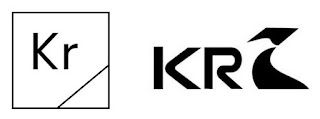TTAB Finds Two KR Design Marks For Cosmetics Confusingly Similar
The Board affirmed a Section 2(d) refusal of the mark shown below left, for "non-medicated skin serums; facial concealer; pre-moistened cosmetic wipes; and skin moisturizer," finding confusion likely with the registered mark shown below right for, inter alia, cosmetics. Applicant Krete LLC argued that the marks are "clearly distinguishable," but the Board pointed out that "it is not necessary for the marks to be indistinguishable to be found similar." Krete also pointed to its ownership of a registration for a similar mark for non-medicated skin serums, but the Board was unimpressed. In re Krete LLC, Serial No. 90369855 (June 24, 2002) [not precedential] (Opinion by Judge Peter W. Cataldo).
Examining Attorney Julie Choe submitted dictionary definitions of "cosmetics" as well as a definition provided by the U.S. Food and Drug Administration (FDA). The Board concluded that Krete's goods fell within those definitions. "Simply put, Registrant’s goods include cosmetics and sub-types of cosmetic and cosmetic components, and Applicant’s goods are types of cosmetics." Seven third-party websites offered, under the same trademark or trade name, goods identified in both the involved application and cited registration.
Krete maintained that its goods are specialty, high end products available in exclusive trade channels, but there were no such limitations in its application. Nor were there any limitations on channels of trade or classes of consumers in the cited registration.
With respect to the marks, the Board found that the "relatively modest geometric designs in the applied-for mark and cited mark do not significantly contribute to the mark’s commercial impression, but rather are subordinate to the letters 'KR' in both marks." The Board observed once again that when a mark is comprised of both literal elements and a design, the literal elements is usually accorded greater weight, in part because consumers are likely to remember and use the letters to request the goods.
Krete pointed to the numeral "7" in the cited mark as a distinguishing element, but the Board found no evidence the consumers would view that design element as the number "7." [Looks like a "7" to me - ed]. Nor was there evidence to support Krete's assertion that its mark is a play on the periodic table of elements, signifying that its goods are "scientific, pure, and clinical."
Turning to Krete's prior registration, Krete invoked the Strategic Partners precedent, but that case applies only in very narrow circumstances. The Board noted that "[i]n this case, Applicant’s prior registration issued in 2021 and thus is not contestable, for a mark with similar elements identifying some of the goods at issue herein." [Huh? "not contestable"? not incontestable? Something is wrong here, not the least of which is using the term "contestable" or "incontestable" to describe a registration - ed.]. While the Board was sympathetic to Krete's position, it concluded that the existence of the prior registration did not outweigh the other DuPont factors.
And so, the Board affirmed the refusal to register.
Read comments and post your comment here.
TTABlogger comment: There is no such thing as an "incontestable" registration. Nowhere in the Lanham Act is the word "incontestable" used in connection with a registration. It is the right to use a registered mark that may become incontestable. See Sections 15 and 33 for proper usage of the term.
Text Copyright John L. Welch 2022.


4 Comments:
Before I even read the text of the post I thought the applicant’s mark resembled an element in the periodic table and that the registrant’s mark was not the number 7 but a wave with a bird or something on top. Even when I look at it as the number 7 I still don’t agree that the marks are confusingly similar. At some point, the board needs to start giving consumers some credit to be able to distinguish between design marks.
Applicant's mark does look like the chemical element symbol for krypton to me. Registrant's mark doesn't convey the same commercial impression, in my opinion.
The reason the TTAB decisions on design marks is so disjointed and inconsistent is that they haven't figured what to say. There is no objective test. They use the case law for standard character marks and never really developed the law for an objective test for comparing designs. The law for comparing design marks is gobbledygook, based on subjective factors, none objective. Most of the decisions center around whether the literal elements outweigh everything else. In most cases, all design elements are not even considered or severely discounted. "The Board observed once again that when a mark is comprised of both literal elements and a design, the literal elements is usually accorded greater weight, in part because consumers are likely to remember and use the letters to request the goods." Really!? Where has this been proven true? Did the TTAB conduct 1000's of surveys to support this notion? I think that rationale is bunk.
If the initials KR were not disclained then I think there is a likelihood of confusion. I would not have appealed. I would have amended the description of goods to be more specific. Just my 2 cents. Steve Fox
Post a Comment
<< Home